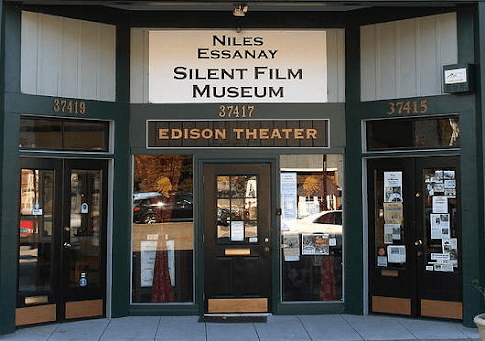Essanay Studios: Silent Film Innovators, the ‘Handsomest Man in the World,’ and the San Diego Tie


Before Hollywood rose to fame as the heart of moviemaking, the American film industry was taking shape in unexpected places like Chicago. One of the most influential studios of the silent era was Essanay Studios, founded in 1907 by George K. Spoor and Gilbert M. Anderson. Its name, derived from the phonetic pronunciation of “S and A,” became synonymous with innovation and creativity, producing films that laid the groundwork for modern cinema.

Essanay’s Beginnings and Influence
Essanay Studios was headquartered in Chicago, with a secondary studio in Niles, CA (now Fremont). It became a powerhouse in early filmmaking, known for producing Westerns, comedies, and dramas. Its influence extended far beyond Chicago and Niles, reaching places like San Diego, where it’s said that some of Essanay’s stars participated in events and garnered widespread recognition.

San Diego played a unique role in the early film industry, with its picturesque landscapes and cultural landmarks serving as backdrops for some productions. During the 1915 Panama-California Exposition held in San Diego’s Balboa Park, silent film star Francis X. Bushman was reportedly crowned the “King of the Movies.” While this claim lacks direct documentation, Bushman’s overwhelming popularity supports the story’s plausibility.
Broncho Billy: The First Cowboy Star
Anderson, one of Essanay’s co-founders, gained fame as “Broncho Billy,” the first major cowboy hero of the silver screen. His Broncho Billy series, the first Western franchise to gain mass appeal, established the genre as an American classic. These films showcased Anderson’s charisma and Essanay’s ability to captivate audiences with thrilling, action-packed stories.
Chaplin at Essanay
In 1915, Essanay made history by signing Charlie Chaplin, then a rising star in silent comedy. During his brief tenure at the studio, Chaplin created 15 films that solidified his reputation as a comedic genius. Classics such as The Tramp and The Bank demonstrated a blend of humor and emotional depth that elevated the art of silent film. Although Chaplin left Essanay for Mutual Film Co. in 1916, his time there left an indelible mark on the studio’s legacy.

The Stardom of Francis X. Bushman
Bushman, one of Essanay’s leading stars, became a cultural icon of the silent era. Dubbed “the handsomest man in the world,” Bushman captured the hearts of audiences with his striking looks and commanding screen presence. His performances in films like Romeo and Juliet (1916) and Ben-Hur: A Tale of the Christ (1925) showcased his versatility and dramatic depth.
Bushman’s role as Messala in Ben-Hur is particularly memorable, with the actor later recalling the grueling preparation for the film’s legendary chariot race sequence. His dedication to his craft earned him a lasting legacy as one of the silent screen’s most celebrated stars.
Essanay’s Decline and Enduring Legacy
Despite its groundbreaking achievements, Essanay Studios closed its doors in 1918, unable to compete with the rising power of centralized Hollywood studios like Paramount and MGM. However, the studio’s contributions to early cinema remain significant. Its role in establishing the Western genre, fostering stars like Anderson and Bushman, and elevating silent comedy with Chaplin’s films helped shape the industry’s future.

San Diego’s Connection to Silent Film
While Essanay’s primary operations were in Chicago and Niles, San Diego’s contribution to the burgeoning film industry cannot be overlooked. Its scenic beauty and events like the 1915 Panama-California Exposition highlighted the city as a cultural hub. Silent film icons like Bushman further cemented San Diego’s place in the history of early cinema.
Through stars such as Chaplin and Bushman, Essanay Studios helped define the silent era of film. Its pioneering work influenced the industry nationwide, bridging cities like Chicago, Niles, and San Diego, and setting the stage for Hollywood’s rise.

Today, Essanay’s legacy lives on through the Niles Essanay Silent Film Museum in Fremont. The museum preserves the studio’s history, showcasing films, artifacts, and memorabilia from its golden years.
Sources
- San Diego History Center: 1915 Panama-California Exposition
- Britannica: Essanay Film Manufacturing Company
- PopMatters: Francis X. Bushman’s Legacy in Silent Cinema
- Niles Essanay Silent Film Museum: History of Essanay Studios
- Charlie Chaplin Archive: The Tramp and Essanay Studios
Categories
Recent Posts










GET MORE INFORMATION


